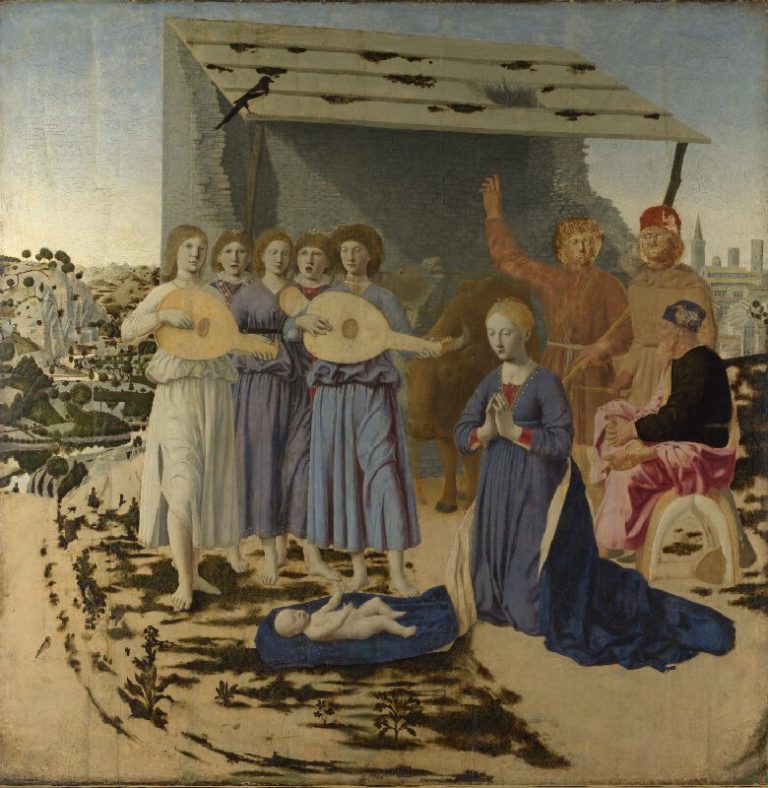By Madeleine Stebbins

This Nativity scene, partly unfinished and also damaged, was painted in the 1470’s by Piero della Francesca. He is a seer into the invisible world. Though with his sense of realism he is fully in this world, he is not of this world. He gives us a glimmer of another world far deeper and infinitely vaster than we had imagined.
This Nativity is depicted in a very real setting: the background resembles the landscape and the buildings of the artist’s hometown of Borgo San Sepolcro in Tuscany. However, the actual Nativity scene itself is in the foreground on a higher platform, signifying a timeless reality, even as it is a historical event. Blessed John Henry Newman said: “How stupendous a mystery is the incarnation.”
In the poverty of this ruin of a stable we see a divine richness that turns upside down all worldly notions of power and glitter by humility and simplicity—that is, true greatness. The Holy Virgin has a sacred dignity in her bearing as she kneels in adoration before the fragile Holy Infant, so poor and naked lying on her cloak, stretching out His arms toward her and the Infant suffuses the whole painting. Piero della Francesca has a special gift for rendering a particular cast of transparent light, akin to a supernatural light, in many of his masterworks. This also enhances the atmosphere of serenity and contemplation.
Every one of the figures here is in profound contemplation. The shepherds on the right in poor, rough clothing seem like prophetic figures, realizing that something extraordinary has taken place. One is pointing upwards as if toward a heavenly visitation, announcing the event. Even the beasts sense something. St. Joseph on the right is deep in “thoughts beyond the reaches of our souls,” to quote Hamlet. He seems to be caught up in a visionary dream. Almost overcome by the greatness of the mystery, he sits down.
The group of singing angels is a superb work of artistic beauty in itself. Peace and grandeur emanate from their interiority. There are of majesty is a visual manifestation of the sublime music they must be pouring forth.
If we compare this Nativity scene with others we become aware of the difference. Whereas most Nativities express the joy, sweetness, and tenderness of Christ’s birth—likened to flowers appearing on earth—this one emphasizes the depth of the mystery. Its ascetical quality prevents and descent into sentimentalism. There is a desert feeling in this painting which gives it its other-worldly stamp. This other-worldliness might seem far removed and alien to us. Some say, “I can not relate to it.” But that is only because our modern life, dominated by the cacophony of electronic media, constant messaging, and other cheap distractions, makes us live on the surface of our souls. We are estranged from our own humanity. But the truth is that it is nearest because we experience is in the sanctuary of our souls. It corresponds to our deepest longing.
The image of the desert conveys this silence. Even the magpie on the roof, usually a chatterbox bird, is silent. The sublime music of the angels, however, never interrupts true silence. We can only enter into the sanctuary when all else vanishes. That is why saints have considered prayer in the poverty of “a desert” to be so important. Grace can then penetrate into the inner sanctuary. Only then can we begin to fathom the great mystery of the Incarnation. “And the Word became flesh and dwelt among us” (John 1:14). The mercy of God has appeared.
Madeleine Stebbins is the author of Looking at a Masterpiece and Let’s Look at a Masterpiece: Classic Art to Cherish with a Child. These poignant works bring timeless truths to life through the beauty of art.